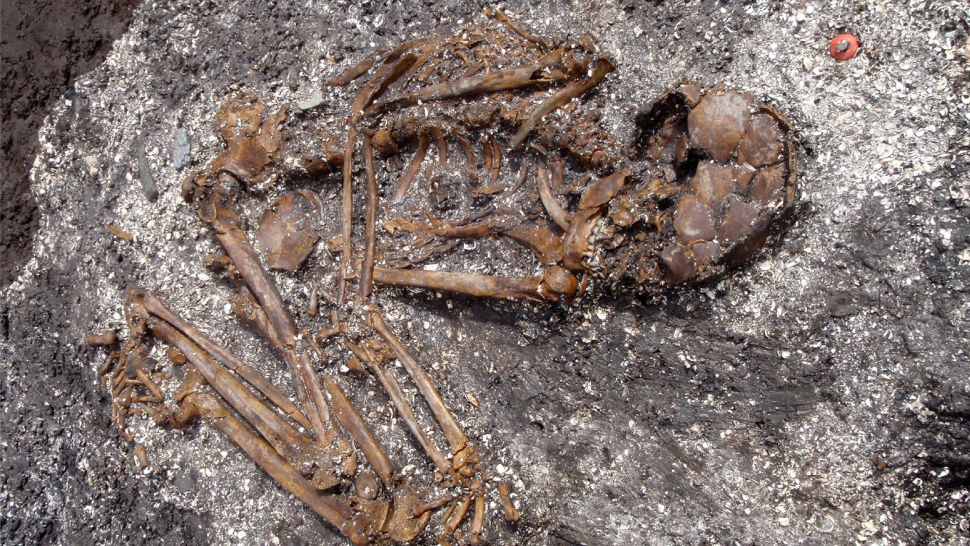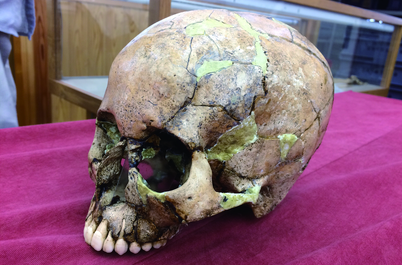DNA Analysis Identifies Japanese Ancestors
Researchers have rewritten Japanese history after uncovering a third, and a previously unknown, group of ancestors that migrated to Japan around 2,000 years ago, of modern-day Japanese populations.

Ancient Japan can be split into three key time periods: the Jomon period (13,000 B.C. to 300 B.C.), a time when a small population of hunter-gatherers who were proficient in pottery lived exclusively on the island; the overlapping Yayoi period (900 B.C. to A.D. 300), when farmers migrated to Japan from East Asia and developed agriculture; and the Kofun period (A.D. 300 to 700) when modern-day Japan began to take shape.
Previous research had suggested the two main genetic origins of modern-day Japanese populations were the original hunter-gatherers who lived during the Jomon period and the farmers who migrated to Japan during the Yayoi period. Now, an analysis of the DNA found in ancient bones has revealed a third genetic origin during the Kofun period, when a group of previously unknown ancestors migrated to Japan, researchers reported in a new study.
“We are very excited about our findings on the tripartite [three-part] structure of Japanese populations,” lead author Shigeki Nakagome, an assistant professor in the School of Medicine at Trinity College Dublin in Ireland, told Live Science. “We believe that our study clearly demonstrates the power of ancient genomics to uncover new ancestral components that could not be seen only from modern data.”
Uncertain origins
The Jomon hunter-gatherers may have first appeared in Japan as early as 20,000 years ago and maintained a small population of around 1,000 individuals for thousands of years, Nakagome said. There is evidence of people living in Japan as far back as 38,000 years ago, during the Upper Paleolithic, the researchers said in a statement, but little is known about these people.
“A long-standing hypothesis is that they were ancestors of Jomon,” Nakagome said. This means that the Upper Paleolithic people may have transitioned into the Jomon people around 16,000 years ago, he added.
Another possible explanation is that Jomon people originated in East Asia and crossed the Korea Strait when it became covered in ice during the Last Glacial Maximum — the most recent time during the Last Glacial Period when ice sheets were at their greatest extent — around 28,000 years ago, according to the statement.
“However, whether these hypotheses are true or not remains unknown due to a lack of Paleolithic genomes from Japan,” Nakagome said.
At the start of the Yayoi period, there was an influx of people from China or Korea with experience in agriculture. These people introduced farming to Japan, which led to the development of the first social classes and the concept of land ownership. The Yayoi period transitioned into the Kofun period, during which the first political leaders emerged and a single nation, which later became modern-day Japan, was formed. However, until now, it was unclear if the Kofun transition was the result of the third mass migration or just a natural continuation of the Yayoi period.
“Cultural transitions could have happened without involving genetic changes,” Nakagome said. “Even if cultures look very different between two periods, it does not mean that process involved gene flow.”
Previous research had suggested a third genetic input from immigrants at the time, but until now, nobody had been able to sequence DNA from any Kofun individuals to find out.
Missing link
In the new study, Nakagome and his team analyzed the genomes of 12 individuals from across Japan. Nine dated to the Jomon period, and three were from the Kofun period, making it “the first study that generated whole-genome sequence data from Kofun individuals,” Nakagome said.

The results revealed that, as predicted by others, a third genetically distinct group of Japanese ancestors migrated to the country during the Kofun period. These ancestors came from East Asia and were most likely Han people from ancient China, Nakagome said.
“Han is genetically close to ancient Chinese people from the Yellow River or West Liao River, as well as modern populations, including the Tujia, She and Miao,” Nakagome said. “We think these immigrants came from somewhere around these regions.”
The team’s findings are not unsurprising to other historians who had suspected that this third group of Japanese ancestors existed.
“Archaeological evidence has long suggested three stages of migration, but the last one has largely been ignored.” Mikael Adolphson, a professor of Japanese history at the University of Cambridge who was not involved with the study, told Live Science. “This new finding confirms what many of us knew, but it is good that we now get evidence also from the medical field.”
The findings also showed that a majority of genes among modern-day Japanese populations originated from East Asia, across the three main periods of genetic mixing. The team’s analysis determined that “approximately 13%, 16% and 71% of Jomon, Northeast and East Asian ancestry, respectively,” Nakagome said. “So, East Asian ancestry is dominant in modern populations.”
However, the study does not shed light on whether the migration of East Asian people contributed to the transition from farming to an imperial state during the Kofun period.
“The Kofun individuals sequenced were not buried in keyhole-shaped mounds [reserved for high-ranking individuals], which implies that they were lower-ranking people,” Nakagome said. “To see if this East Asian ancestry played a key role in the transition, we need to sequence people with a higher rank.”
Nakagome and his team are excited to have helped confirm a new piece of Japan’s history and hope the findings can open the door to further discoveries. It is important to know “where we came from and the unique history of our own ancestors,” he said.
The study was published online on Sept. 17 in the journal Science Advances.





